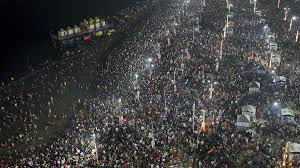
Outline:
Introduction
- Overview of the Kumbh Mela festival
- Significance of the January 29, 2025 event
The Tragic Incident
- Detailed account of the crowd crush
- Eyewitness testimonies
- Immediate aftermath and emergency response
Casualties and Injuries
- Official reports on fatalities and injuries
- Personal stories of the victims
- Impact on families and communities
Government and Official Responses
- Statements from Prime Minister Narendra Modi
- Actions taken by the Uttar Pradesh government
- Involvement of local authorities and emergency services
Historical Context of Crowd-Related Incidents at Kumbh Mela
- Previous incidents in 1954 and 2013
- Lessons learned and safety measures implemented over the years
Crowd Management Strategies at Religious Festivals
- Importance of effective crowd control
- Techniques and technologies used in large gatherings
- Challenges faced in managing massive crowds
Implementation of AI and Technology in Crowd Control
- Deployment of AI-based systems at the 2025 Kumbh Mela
- Effectiveness of technology in preventing such incidents
- Future prospects of tech integration in crowd management
Religious Significance of the Kumbh Mela
- The spiritual importance of bathing at the confluence
- The festival’s role in Hindu culture and tradition
- The allure that draws millions to the event
Impact on Pilgrims and Devotees
- Emotional and psychological effects on attendees
- Changes in participation following the incident
- Support systems for affected individuals
Media Coverage and Public Perception
- Analysis of national and international media reports
- Public reactions and discourse on social platforms
- The role of media in shaping narratives
Safety Protocols and Recommendations for Future Events
- Evaluation of current safety measures
- Expert suggestions for improvement
- The balance between tradition and modern safety needs
Community and Religious Leaders’ Perspectives
- Insights from spiritual leaders
- Community responses and solidarity
- The role of faith in healing and moving forward
Legal and Ethical Considerations
- Accountability and legal implications
- Ethical responsibilities of organizers and authorities
- Rights of the victims and their families
Global Comparisons: Crowd Management in Major Events
- How other countries handle large gatherings
- Lessons that can be applied to the Kumbh Mela
- The universality of crowd management challenges
Conclusion
- Reflecting on the tragedy and its broader implications
- The path forward for safer religious gatherings
- Honoring the memory of the victims
Article:
Introduction
The Kumbh Mela stands as one of the most significant religious gatherings globally, attracting millions of Hindu devotees to the sacred confluence of the Ganges, Yamuna, and the mythical Saraswati rivers in Prayagraj, India. This festival, held every twelve years, is a profound expression of faith, with pilgrims believing that bathing in these holy waters absolves sins and grants liberation. However, the 2025 Kumbh Mela was marred by a tragic incident on January 29, when a devastating crowd crush resulted in numerous fatalities and injuries, casting a somber shadow over the spiritual event.
The Tragic Incident
In the early hours of January 29, 2025, as the first light of dawn touched the horizon, tens of thousands of devotees converged at the Sangam—the sacred confluence—to perform the ritualistic holy dip. The atmosphere, charged with devotion, soon turned chaotic. Reports indicate that around 4 a.m., a sudden surge in the crowd led to the collapse of crowd control barriers. This breach caused panic among the pilgrims, resulting in a deadly stampede. Eyewitnesses recounted harrowing scenes of individuals being trampled, cries for help echoing amidst the chaos, and the sheer helplessness that pervaded the moment. Emergency services were promptly deployed, but the density of the crowd impeded swift rescue operations, exacerbating the tragedy.
Casualties and Injuries
Initial reports from various news outlets painted a grim picture. The Guardian reported at least 38 fatalities, with fears that the number could rise as rescue operations continued.
Reuters confirmed more than seven deaths and approximately ten injuries, noting that the initial stampede began around 1 a.m., with the situation escalating as devotees attempted to escape.
The Times added that at least 15 individuals lost their lives due to the collapse of crowd control barriers.
Personal stories emerged of families torn apart, with many searching desperately for missing loved ones amidst the turmoil. The emotional toll on the victims’ families and the broader community is immeasurable, with many grappling with grief and seeking answers in the aftermath.
Government and Official Responses
In the wake of the tragedy, Prime Minister Narendra Modi expressed profound sorrow and called for immediate measures to address the situation. He emphasized the need for a thorough investigation to understand the causes and to prevent such incidents in the future. The Uttar Pradesh government, under Chief Minister Yogi Adityanath, mobilized all necessary resources to aid in rescue and relief operations. Authorities urged pilgrims to adhere to safety protocols and avoid overcrowded areas, emphasizing the importance of following official instructions during such massive gatherings. Local officials coordinated with emergency services to ensure timely medical assistance for the injured and to manage the crowd effectively in the aftermath.
Historical Context of Crowd-Related Incidents at Kumbh Mela
The Kumbh Mela has a history of tragic crowd-related incidents. In 1954, a catastrophic stampede resulted in over 400 deaths, marking one of the deadliest events in the festival’s history. More recently, in 2013, another stampede led to 36 fatalities, underscoring the persistent challenges of managing such vast congregations. These incidents have prompted authorities to implement various safety measures over the years, including improved crowd control strategies and infrastructure enhancements. However, the recurring nature of these tragedies highlights the need for continuous evaluation and adaptation of safety protocols to address the evolving dynamics of the festival.
Crowd Management Strategies at Religious Festivals
Effective crowd management is crucial in ensuring the safety of participants in large religious gatherings like the Kumbh Mela. Strategies include:








